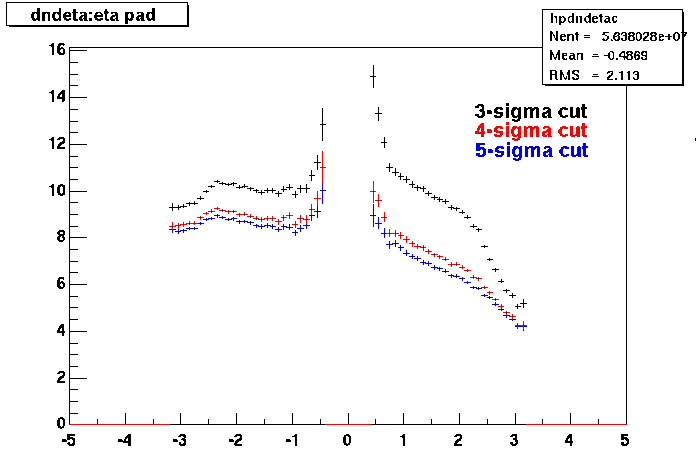a) Why does the multiplicity distribution have a long tail. Possibly solved by item 1.
b) Why is there a "kink" in the pad dN/deta at eta = -2.5 (and maybe +2.5)
c) Verify mapping (i.e. translation of packet number to physical location)
d) Verification of geometry (I think the pad detector geometry is oversimplified in the analysis -- not sure if it matters)
a) I do not have a plot to demonstrate the long tail on the multiplicity
distribution. Obviously, we will need to understand this and hope that
we can either
i) understand the cause of this class of events, and find cuts
to reject them, and justify making these cuts.
or
ii) fix the problem through better calibrations (which we hope will happen)
b) Why is there a "kink" in the pad dN/deta at eta = -2.5 (and maybe +2.5)
See this plot (from pad detectors, showing 3,4,5 sigma pedestal cuts)
to see the "kink":

c) Verify mapping (i.e. translation of packet number to physical location)
The is a database entry (and a delated ascii file we use in test macros) which contains the information to translate packet number in the MVD to the x,y,z location. We need to make sure this is right. This document contains my best understanding of this mapping (plus a lot of other related information).
d) Verification of geometry (I think the pad detector geometry is oversimplified in the analysis -- not sure if it matters)
We use an idealized version of the pad detector geometry. I am sure it is close to correct. I am also sure it is not exactly correct. I am not sure if the small differences are important. This needs to be clarified.
e) Are dead channels dealt with correctly?
There is a dead channel map, but I am not sure it is correct or that the code deals with it correctly.
updated August 15, 2003
John P. Sullivan
sullivan@lanl.gov